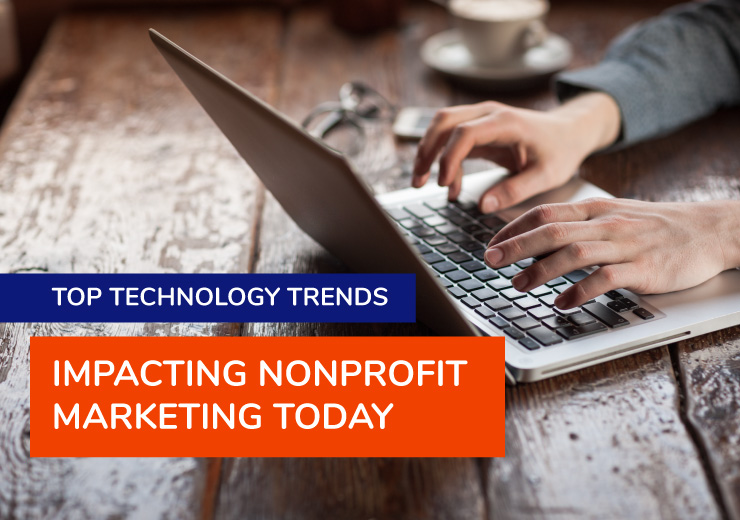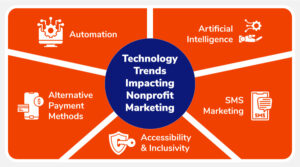5 Technology Trends Impacting Nonprofit Marketing Today

Moving into the new year, nonprofit professionals everywhere are thinking about what they can do differently to improve their organization’s results. As you plan your fundraising activities, choose marketing strategies, and set your annual goals, reading up on the latest giving trends can help you align your approach with what’s going on in the wider nonprofit community.
But don’t just pay attention to what’s going on in the world of giving—technological innovations can also affect how your nonprofit markets itself and how your audience responds. In particular, technology trends are bound to play a part in your organization’s digital marketing efforts.
To keep you up-to-date, let’s explore a few of the latest technology trends that may impact your marketing strategy this year:
1. Nonprofits Seek More Automation
In one technology trend report, over 40% of nonprofits said their top internal challenge was a lack of process automation and efficiency. Nonprofit staff are pressed for time, and manually completing tasks like data entry or follow-up communications takes up too much of it.
To save your team time, energy, and resources, use the right technology to automate any of your internal processes that don’t require a human touch.
For example, Redpath’s Salesforce Marketing Cloud guide explains how this tool allows you to set up automated email streams that are highly customized and triggered by donors’ actions. All you have to do is create the email stream once, then the software will automatically send the right emails to the right donors without any additional action needed.
Other digital tools like matching gift software are developing more automation features to help nonprofits improve the speed and success of their marketing efforts. By automating matching gift outreach, these tools can identify donors who are match-eligible and send them personalized emails without extra work required from your nonprofit.
Tap into this trend by taking time to explore any automation features that your technology already has or looking into additional tools your nonprofit can leverage to reach your marketing goals.
2. The Rise of Artificial Intelligence
Everyone’s been talking about AI across industries, so it’s no surprise that the time has come for nonprofits to embrace this emerging technology.
Nonprofits are leveraging AI in a variety of ways to make their marketing processes more efficient and effective. Common uses include:
- Sourcing ideas for marketing emails, social media posts, direct mail appeals, and texts.
- Analyzing donor data and using patterns to predict donor behavior.
- Saving staff time by creating mock-ups of written or visual marketing content.
- Adding AI chatbots to nonprofit websites to help donors quickly find the information they need to get involved.
Free generative AI bots like ChatGPT can perform some of these actions, but others will require you to invest in more specialized tools like a CRM with built-in AI capabilities. For example, Salesforce for Nonprofits now includes access to Salesforce’s predictive AI tool, Einstein. This tool can predict the likelihood of specific contacts in your database becoming donors and tell you how much they’re likely to give, helping you tailor your fundraising appeals.
3. More Focus on SMS Marketing
More and more organizations are adding SMS to their multichannel marketing strategies. Text messages are highly versatile and can be used for everything from donation appeals to donor stewardship to soliciting feedback. Nonprofits are prioritizing SMS right now because text messages:
- Have extremely high open rates. According to Mogli, text messages typically have a 98% open rate and a 19% click-through rate. This means your messages won’t get lost in overcrowded inboxes like emails and that recipients are far more likely to read your message and take action.
- Feel personal to supporters. Texts don’t feel as formal as emails do, making them a great channel for connecting one-on-one with donors. Plus, it’s easy for recipients to respond directly if they have a question.
- Are fast and reliable. Your team won’t have to spend nearly as much time drafting a text message as they would an email. Texts can also be sent out on short notice to alert supporters quickly about an urgent update or call to action.
Improvements in nonprofit texting technology are supporting this increase in popularity. With an SMS marketing app, for example, you can send bulk texts, have one-to-one conversations, and even create in-text surveys that send data from responses right to your CRM.
To tap into this trend, research options for specialized SMS marketing software or other marketing automation tools that include texting capabilities. Then, think about how texts might fit into your existing marketing and communications strategies.
4. Ensuring Accessibility and Inclusivity
Accessibility and inclusivity are more important than ever in the nonprofit sector, and this is especially true for your organization’s digital marketing efforts. While technology vendors are working to make the latest technology more accessible to smaller nonprofits with low budgets, organizations are emphasizing accessibility in their communications with supporters.
By taking steps to make your communications more accessible, you’ll show donors that your organization’s community is welcoming and accepting, cultivating a more positive reputation and community. Plus, improving your website’s accessibility can directly lead to more fundraising revenue since it makes it easier for donors to give.
Start by taking the following actions to make your website more accessible:
- Optimize your website for mobile devices and screen readers. This is especially important for crucial pages like your donation page, registration forms, and contact page.
- Add alt text for images and captions for videos. Add descriptive text to the visuals on your website and in your social media content.
- Compress images to reduce page load times. Your website will be much more accessible if users can access your site’s content quickly and easily.
- Create more inclusive marketing content. Feature diverse groups of people in your images, address supporters from all walks of life, and avoid using overly complex language.
Additionally, consider adding a note on your website’s homepage or contact page encouraging users to reach out about ways you can make your site more accessible for them. Take all feedback into consideration and work with your team’s IT specialists or an outside agency to implement any necessary changes.
5. Accepting Alternative Payment Methods
New technologies are making it possible for nonprofits to accept all kinds of payment methods for donations. From peer-to-peer platforms like Venmo to tools that help you accept stock and cryptocurrency donations, there are plenty of solutions you can leverage to give your donors more ways to give.
Once you select a tool to use to accept more payment methods, take these steps to get the word out:
- Expand the donation options on your Ways to Give page. List all of the payment methods donors can choose from, such as cash, credit cards, PayPal, and cryptocurrency. Be sure to explain how to donate using each payment type.
- Highlight new ways to give. Next, market your new giving options in your fundraising appeals and marketing campaigns.
- Create marketing materials you can reuse. These may include social media infographics that explain the benefits of donating stocks or step-by-step emails you can send out when anyone has questions about using one of your new payment solutions.
Even if some of these alternative payment methods don’t stick around for decades, it’s still worthwhile to let donors know that you accept all the giving methods they may be interested in using now. The more options you can provide donors with, the more audience members you’ll appeal to.
If you want more insight into how your organization can personally tap into these and more emerging technology trends, reach out to a nonprofit technology consultant. These experts can analyze your organization’s current technology usage, recommend ways to improve your tech stack, and implement major changes for you.



